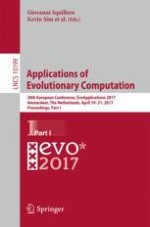2017 | OriginalPaper | Chapter
Interactive Evolution of Complex Behaviours Through Skill Encapsulation
Authors : Pablo González de Prado Salas, Sebastian Risi
Published in: Applications of Evolutionary Computation
Publisher: Springer International Publishing
Activate our intelligent search to find suitable subject content or patents.
Select sections of text to find matching patents with Artificial Intelligence. powered by
Select sections of text to find additional relevant content using AI-assisted search. powered by
